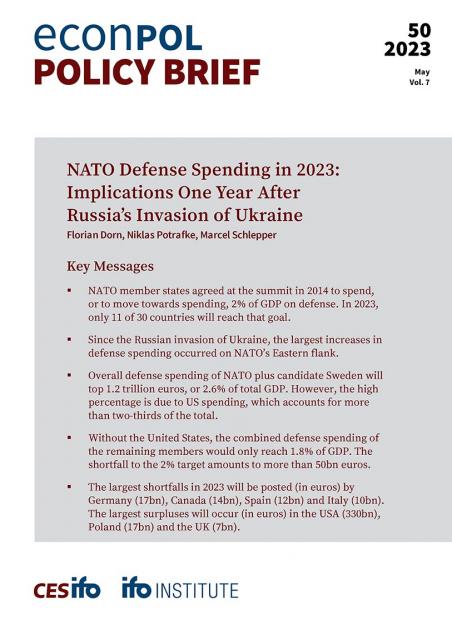NATO Defense Spending in 2023: Implications One Year After Russia’s Invasion of Ukraine
Key Messages
- NATO member states agreed at the summit in 2014 to spend, or to move towards spending, 2% of GDP on defense. In 2023, only 11 of 30 countries will reach that goal.
- Since the Russian invasion of Ukraine, the largest increases in defense spending occurred on NATO’s Eastern flank.
- Overall defense spending of NATO plus candidate Sweden will top 1.2 trillion euros, or 2.6% of total GDP. However, the high percentage is due to US spending, which accounts for more than two-thirds of the total.
- Without the United States, the combined defense spending of the remaining members would only reach 1.8% of GDP. The shortfall to the 2% target amounts to more than 50bn euros.
- The largest shortfalls in 2023 will be posted (in euros) by Germany (17bn), Canada (14bn), Spain (12bn) and Italy (10bn). The largest surpluses will occur (in euros) in the USA (330bn), Poland (17bn) and the UK (7bn).
War is raging close to NATO's Eastern border. Russia has attacked Ukraine and threatens those states that in the past had been part of Moscow's sphere of influence. Many of them are now member states of NATO. As a collective defense alliance, this poses a threat to all NATO members. Since the ability to defend against an aggressor does not come for free, defense spending will be on the agenda at the NATO Summit in Vilnius in July 2023. NATO Secretary General Jens Stoltenberg has already expressed his expectation that all member states no longer see the 2% target as a mere ambition, but as the floor for their future defense spending. This paper presents first results for the expected defense spending of the 30 NATO members and the candidate country Sweden in 2023.
Florian Dorn, Niklas Potrafke, Marcel Schlepper: “NATO Defense Spending in 2023: Implications One Year After Russia’s Invasion of Ukraine,” EconPol Policy Brief 50, May 2023.
